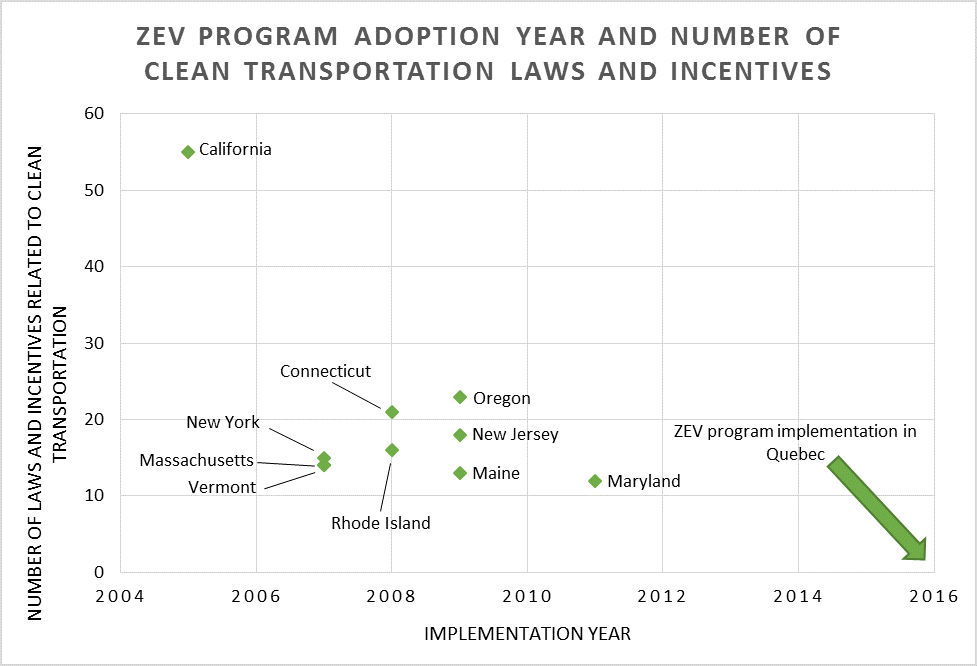Market Snapshot: Quebec leads Canada in zero-emission vehicle policy
Release date: 2018-04-04
A zero-emission vehicle (ZEV) is a vehicle that is capable of operating with no tailpipe pollution. The most common types are pure battery-electric and plug-in hybrid electricFootnote 1. To encourage lower carbon emissions, different jurisdictions are introducing regulations and initiatives to foster the adoption of non-emitting vehicles for personal transportation. In October 2016 the government of Quebec passed the ZEV Act. The Act gives the Government of Quebec the power to require car manufacturers to sell or lease a minimum number of ZEVs through a system of tradable credits. In May 2017, the Government of Canada announced it would also develop its own national ZEV strategy by 2018. This strategy, along with demand-side initiatives and policies, is focused on reducing GHGs in the individual transportation sector.
Quebec is the first province in Canada to adopt this kind of program. However, 10 American states have already adopted similar policies aimed at increasing the supply of ZEVs on the market. In turn, more ZEV manufacturers implies an increasing diversity and a higher market penetration potential by this type of vehicle.
The ZEV Program is a California state regulation requiring manufacturers to produce an increasing number of ZEVs. It was implemented in California in 2005, and similar programs were then adopted by 9 other states. The chart below illustrates the adoption year of ZEV programs or policies by the states that followed California. The adoption of a similar ZEV program came years later in Quebec, which is currently the leader in ZEV adoption in Canada. In addition, the vertical axis illustrates the number of clean transportation laws, regulations and funding opportunities in the different states that adopted California’s ZEV program. These numbers do not indicate the strength or effectiveness of the regulations, but rather illustrate interest in greening the personal transportation system. Quebec is pictured as a vertical line as there are no specific number of laws and incentives relative to ZEVs, but rather a larger framework within which they have been implemented.

Source and Description
Source: U.S. Department of Energy, California Air Resources Board and Quebec Ministry of Sustainable Development, Environment, Wildlife, and Parks.
Description: This chart shows the year of implementation of the ZEV program and number of clean transportation laws in 10 American states, as well as the year of implementation of a similar ZEV program in Quebec.
- California implemented the ZEV program in 2005 and has adopted 55 other laws and incentives on clean transportation.
- Massachusetts implemented the ZEV program in 2007 and has adopted 15 other laws and incentives on clean transportation.
- New York and Vermont both implemented the ZEV program in 2007 and have adopted 14 other laws and incentives on clean transportation.
- Connecticut implemented the ZEV program in 2008 and has adopted 21 other laws and incentives on clean transportation.
- Rhode Island implemented the ZEV program in 2085 and has adopted 16 other laws and incentives on clean transportation.
- Maine implemented the ZEV program in 2009 and has adopted 13 other laws and incentives on clean transportation.
- New Jersey implemented the ZEV program in 2009 and has adopted 18 other laws and incentives on clean transportation.
- Oregon implemented the ZEV program in 2009 and has adopted 23 other laws and incentives on clean transportation.
- Maryland implemented the ZEV program in 2011 and has adopted 12 other laws and incentives on clean transportation.
- Quebec implemented a ZEV framework in 2016.
- Date modified:
